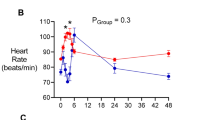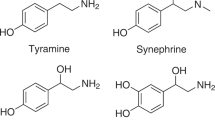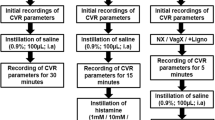Abstract
STIMULATION of the splenic nerves releases prostaglandins from the spleen to give concentrations of as much as 0.2 µg/ml. in splenic venous blood1. The release of prostaglandins might influence organs remote from the site of release, for prostaglandins can exert potent actions on smooth muscle2. The lung has recently been shown to determine the fate of many vasoactive substances; some are activated—conversion of angiotensin I to angiotensin II (ref. 3)—and some inactivated. The degree of inactivation seems to be specific for a given substance, ranging from almost complete (bradykinin4, 5-hydroxytryptamine5, prostaglandins E1 E2 and F2α (ref. 1)), to minor (noradrenaline6), to allowance of their free passage (adrenaline6 and angiotensin II (ref. 7)). The removal of prostaglandins by the lung restricts their activities to the organs from which they are released and between their organ of origin and the site in the pulmonary circulation where they are inactivated1. A prostaglandin which passed through the lungs after its release from an organ could be considered a circulating hormone, as long as it is not rapidly degraded in the blood. Ferreira and Vane1 reported that prostaglandins E1 E2 and F2α were stable in blood, though rapidly inactivated by the lung. Removal of prostaglandins A1 and A2 by the lung was not determined because the assay organs are insensitive to them. Vascular smooth muscle, however, unlike other smooth muscle, is reactive to low concentrations of prostaglandins A1 and A2 (refs. 8–10) and the renal vasculature is probably most sensitive to prostaglandins A1 and A2 (refs. 10 and 11). Because the renal vasculature is also sensitive to prostaglandins E1 and E2 (ref. 12), it has been used as an index of the fate of prostaglandins infused into the venous and arterial circulations.
This is a preview of subscription content, access via your institution
Access options
Subscribe to this journal
Receive 51 print issues and online access
$199.00 per year
only $3.90 per issue
Buy this article
- Purchase on Springer Link
- Instant access to full article PDF
Prices may be subject to local taxes which are calculated during checkout
Similar content being viewed by others
References
Ferreira, S. H., and Vane, J. R., Nature, 216, 868 (1967).
Bergström, S., Carlson, L. A., and Weeks, J. R., Pharmacol. Rev., 20, 1 (1968).
Ng, K. K. F., and Vane, J. R., Nature, 216, 762 (1967).
Ferreira, S. H., and Vane, J. R., Brit. J. Pharmacol. Chemother., 30, 417 (1967).
Thomas, D. P., and Vane, J. R., Nature, 216, 335 (1967).
Ginn, R. W., and Vane, J. R., Nature, 219, 740 (1968).
Hodge, R. L., Ng, K. K. F., and Vane, J. R., Nature, 215, 138 (1967).
Vander, A. J., Amer. J. Physiol., 214, 218 (1968).
Herzog, J. P., Johnston, H. H., and Lauler, D. P., in Prostaglandin Symp. Worcester Foundation for Exp. Biol. (edit. by Ramwell, P. W. and Shaw, J. E.), 147 (Interscience, 1968).
Strong, C. G., and Bohr, D. F., Amer. J. Physiol., 213, 725 (1967).
Lee, J. B., in Prostaglandin Symp. Worcester Foundation for Exp. Biol. (edit. by Ramwell, P. W. and Shaw, J. E.), 131 (Interscience, 1968).
McGiff, J. C., Terragno, N. A., Ng, K. K. F., and Lee, J. B., Fed. Proc., 28, 286 (1969, abstract).
Vane, J. R., Brit. J. Pharmacol. Chemother., 23, 360 (1964).
Gilmore, N., Vane, J. R., and Wyllie, J. H., Nature, 218, 1135 (1968).
Bygdeman, M., and Samuelsson, B., Clin. Chim. Acta, 10, 566 (1964).
Ånggård, E., and Samuelsson, B., J. Biol. Chem., 239, 4097 (1964).
Ånggård, E., and Samuelsson, B., in Prostaglandins, Proc. Second Nobel Symp. (edit. by Bergström, S. and Samuelsson, B.), 97 (Interscience, 1967).
Lee, J. B., Gougoutas, J. Z., Takman, B. H., Daniels, E. G., Grostic, M. F., Pike, J. E., Hinman, J. W., and Muirhead, E. E., J. Clin. Invest., 45, 1036 (1966).
Lee, J. B., Crowshaw, K., Takman, B. H., Attrep, K. A., and Gougoutas, J. Z., Biochem. J., 105, 1251 (1967).
Daniels, E. G., Hinman, J. W., Leach, B. E., and Muirhead, E. E., Nature, 215, 1298 (1967).
Ramwell, P. W., Shaw, J. E., and Kucharski, J., Science, 149, 1390 (1965).
Ramwell, P. W., Shaw, J. E., Douglas, W. W., and Poisner, A. M., Nature, 210, 273 (1966).
Author information
Authors and Affiliations
Rights and permissions
About this article
Cite this article
MCGIFF, J., TERRAGNO, N., STRAND, J. et al. Selective Passage of Prostaglandins across the Lung. Nature 223, 742–745 (1969). https://doi.org/10.1038/223742b0
Received:
Revised:
Issue Date:
DOI: https://doi.org/10.1038/223742b0
This article is cited by
-
Adventures and Excursions in Bioassay: The Stepping Stones to Prostacylin
Bioscience Reports (2004)
-
Cardiac and microcirculatory effects of different doses of prostaglandin E1 in man
European Journal of Clinical Pharmacology (1987)
Comments
By submitting a comment you agree to abide by our Terms and Community Guidelines. If you find something abusive or that does not comply with our terms or guidelines please flag it as inappropriate.



